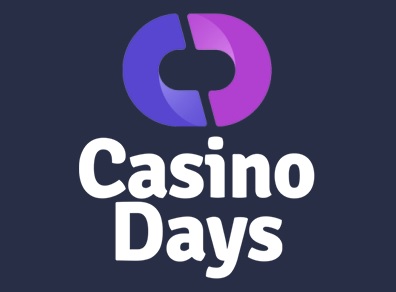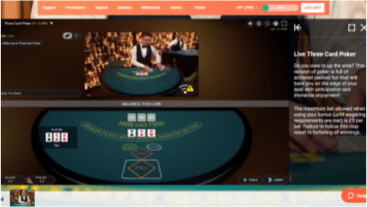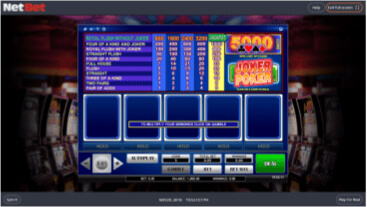Online Poker
Is there a card game out there more famous than poker? We don’t think so. Even non-gamblers know about it and have probably indulged in a game or two in their lives. Dedicated players love it for its combination of skill, strategy and luck. With legions of fans around the world, Poker is a classic table game that every casino has.
While not simple, Poker can be learnt and mastered by those dedicated enough to want to understand the game. Perhaps that’s why even amateur players have been known to win big. Whether you’re a newcomer or an experienced player, read on to learn more about this famous and fascinating game.
How to Play Poker
Poker can be very fun, yet it takes brainpower, strategy and luck to succeed. The rules can seem fairly complicated, but once you learn them, you are on your way to enjoying one of the greatest games in history. Any number of players, typically from two to ten, can play.
One of the most common types of poker is five card draw. Each player is dealt five cards, then everyone bets. Afterwards, each player has the option to get rid of up to 3 cards and replace them with cards from the top of the deck.
Another variation is Texas hold ’em. In this variation, each player is dealt two cards face down. These are called your ‘hole cards.’ Then, there is a round of betting in which you can check, bet or fold.
These terms will be explained in detail in the next section, but for now, familiarize yourself with the following hands from highest to lowest value to understand the very basics of card combinations in Poker:
- Straight Flush: Five cards in numerical order, all of the same suit. The best possible straight flush is known as a royal flush, which consists of an ace, king, queen, jack and ten of the same suit. A royal flush is an unbeatable hand.
- Four of a Kind: Four cards of the same rank and one side card. For example, four kings and an eight.
- Full House: Three cards of the same rank and two cards of a different, matching rank. For example, three kings and two eights.
- Flush: Five cards of the same suit. For example, queen, ten, nine, seven and five, all clubs.
- Straight: Five cards in sequence. For example, two, three, four, five and six, of any suit.
- Three of a kind: Three cards of the same rank and two unrelated side cards. For example, three eights, a five and a six.
- Two pair: Two cards of a matching rank, another two cards of a different matching rank and one side card. For example, two tens, two nines and a jack.
- One pair: Two cards of a matching rank and three unrelated side cards. For example, two jacks, ace, eight and five.
- High card: Any hand that does not qualify under a category listed above. For example, king, jack, ten, eight and six.
The Rules of Poker
First things first. When a player enters a game, they must make a full buy-in for that particular game. A full buy-in at limit poker is at least 10 times the maximum bet for the game being played. A full buy-in at pot-limit or no-limit poker is 40 times the minimum bring-in.
Poker is played with a standard pack of 52 cards. Each hand contain five cards. After everyone has bet, the winner of the round is the player with the highest hand. Players must ante just to get dealt cards. An ante is simply a stake put up by a player in poker and similar games before receiving cards.
After that, players receive their cards and bet into the pot in the middle. Depending on the type of poker, more rounds of betting may occur. At the end of the game, anyone who hasn’t folded shows their cards in what’s referred to as the ‘the showdown.
When it’s your turn to bet, you have one of three choices:
- Call – you bet the minimum amount to continue playing.
- Raise – When you raise, you first bet enough to match what has been bet before (a call bet), then you raise the bet amount. Typically, there’s a limit to this amount.
- Fold – you drop out of the current hand and lose any possibility of winning the pot. You also lose your bet, but you don’t have to put any more money into the pot.
Typically, poker games have the following limits:
- No Limit – each player can bet or raise by any amount up to and including their full stack (the total number of chips they possess at any given time) in any betting round on their turn.
- Pot Limit – each player can bet or raise by any amount up to and including the size of the total pot at that time.
- Fixed Limit – each player can choose to call, bet or raise, but only by a fixed amount. The fixed amount for any given betting round is set in advance.
The Objective of Poker
The objective of poker is quite simple: win money by capturing the pot, which holds all bets made by players during the hand. How you do this depends on a number of things – not just the strength of your hand. A good player bets in hopes that he has the best hand or to give the impression that he holds a strong hand, thus convincing his opponents to fold their hands.
In a way, poker is the ultimate midgame. It takes great skill to convince other players that you have a great hand, even if you don’t. Equally, it takes great skill to see if your opponents actually have good hands or if they are just bluffing.
Poker Game Probabilities
A knowledgeable poker player must have a fair idea of the odds and probabilities of the game. Without such knowledge, there is no good way to decide the next course of action in the situations and hands that arise. Being able to analyse a situation mathematically in order to make a decision can help players understand the probabilities of poker. It can also be helpful to memorize the probabilities of certain hands occurring, as listed below.
| Royal Flush | 0.000154% |
| Straight Flush | 0.00139% |
| Four of a Kind | 0.0240% |
| Full House | 0.1441% |
| Flush | 0.1965% |
| Straight | 0.3925% |
| Three of a kind | 2.1128% |
| Two pair | 4.7539% |
| One pair | 42.2569% |
| High card | 50.1177% |
Best Canadian Casinos to Play Poker
Top Poker Strategies
Poker is easy to learn but hard to master, and reaching a level where you are winning regularly takes both time and effort. Since it’s a mathematical game as well as a game of chance, winning poker begins with understanding which starting hands are worth playing. If you enter the pot with the best hand more often than your opponents, you will win more times than your opponents. However, a winning hand is just one part of the strategy. Knowing how to determine pot odds, recognize betting patterns, bluff and use position all come into play and are important strategies to employ in your poker game.
Below, we have listed our four favourite online casinos to play poker as a player from Canada. All these online casinos feature fast and easy payments by card, e-wallet, as well as Interac, iDebit and InstaDebit. If you play at one of these online casinos, you can also benefit from an exclusive welcome bonus!
Bluffing
Simply put, this strategy involves betting or raising with a not-so-great hand that has little to no chance of winning or improving. This is called a pure bluff. A partial bluff means bluffing on an inferior hand that might improve in a later round. The pot can be won if all your opponents fold straight away or if you get a card that significantly improves your hand.
This strategy is more effective in some circumstances than others. Bluffs are more likely to work when the probability of being called is low. There are several factors that increase the probability of being called, including the number of opponents who must fold, observed betting patterns and the players’ states of mind during the game.
There is also an optimal bluffing frequency in poker. If a player bluffs too infrequently, opponents can deduce that the player is betting for value and will call with very strong hands or with drawing hands only when they are receiving favourable pot odds. If a player bluffs too frequently, opponents snap off his bluffs by calling or re-raising.
Bluffing is a necessary part of the game, and without it, poker would be pretty boring. It’s great fun trying to figure out if an opponent is bluffing or not.
Tight/Loose Play
Playing tight means taking a cautious approach to poker while playing fewer hands and folding weaker hands. Aspects of this strategy include playing only with a narrow range of hands, most of which are good. A tight player can sometimes see little action, with many players often folding or waiting for others to call, bet or raise instead of them. For any novice player, a tight style of play is undoubtedly the best choice, allowing you to play it safe while understanding the ins and outs of the game. Playing strong hands and giving up weak hands, looking out for profitable situations and taking advantage of them are all characteristics of tight play.
Loose play, as you can imagine, means the opposite. This strategy is characterized by playing a wide range of hands, including weak ones. A loose game is one where many players are active and thus large pots are common? Once you master the basics of poker, this is a good strategy to start using, but in order to be successful as a loose player, you must be able to read your opponents.
Aggressive/Passive Play
These strategies combine with the above tight/loose strategies to form four general playing styles. Knowing these will help you to predict a player’s actions.
- Tight Passive – This type of player usually won’t play many pots and will play with so much caution that when they do play, everyone else folds. Sometimes labelled as a ‘rock,’ they are easy to bluff and will frequently fold to scary board cards. They are really apprehensive players that can be fearful and cautious – they won’t take shots because they tend to play with an apprehensive style. If you notice a timid player whose moves you can predict, look out for hands and instances where you can gain an advantage over them.
- Loose Passive – These types of players rarely take chances or play aggressively and prefer to watch and let others do the risking. Many beginners can fall into the trap of only calling over and over. This is especially common in low buy-in games. They are very easy to identify, making them easy prey. But, you’re not able to bluff someone who calls continually. Though when you do get a relatively strong hand, go ahead and bet for value to get as much out of the loose passive player as you can.
- Tight Aggressive – Players using this strategy don’t typically play many pots. They’re rather selective and only play the best starting hands. A tight-aggressive player will be patient and calm, waiting for the best opportunities. Often called ‘sharks’, these tight-aggressive players are a force to be reckoned with and often can obtain effective results.
- Loose Aggressive – These types of players can be extremely difficult to read because they play such a wide range of hands. Using their chips as weapons, they are always applying pressure on their opponents. Loose aggressive players are hard to play against. They can get extreme, and it may appear as if they raise their bets without rhyme or reason. This proclivity to overplay is a weakness you may be able to take advantage of.
Hand Reading
While it may seem impossible to read your opponent’s hand, this strategy is actually founded upon deductive logic. Players observe data about how their opponent is playing, compare that data to their past experiences to form educated guesses about how the opponent will play in the future and then use those assumptions to interpret an opponent’s actions. There are a few basic assumptions about your opponents’ play that you need to recognize for hand reading to be an effective strategy.
The first assumption you need to make is that your opponent will not make a bet with a marginal hand, meaning he will be reasonably sure that he has the better hand and that you will call with a worse hand before he tries to bet for value. This technique works best against more timid players.
The second assumption is that your opponent will not bluff on a good hand. If he has hopes of winning at showdown, then his aim will be to get to showdown at low cost. If he does bluff, you have to assume it’s because he believes his chances of winning are low or non-existent.
The third and final assumption is that your opponent will not go after a draw if he has obviously bad odds.
Remember that there are no absolutes in these assumptions, and studying your opponents is crucial.
Studying your opponents’ moves is the key here. Every time a new player joins the table, you have to start watching his or her game while also continually re-assessing the existing players. Players will change strategies throughout the game, and you need to be able to pick up on that to be able to try and predict their next move. Poker is a mind game, after all, and knowing your opponents is just as important as the hand you are dealt.

High Limit Poker – the Ultimate Thrill
Perhaps one of the most thrilling aspects of online gaming are high-stakes games, and poker is no exception. Since it’s a game of chance as well as skill, this makes it even more exciting. High-rollers are not relying only on the strength of their cards but on their observational ability and response to high-pressure situations.
We’ve gathered some of the best online casinos where you can play high-stakes poker right now. It’s time to focus on the game instead of endlessly searching for the best value and highest limits. Experience the thrill of high-limit poker at home or on the go with online games that recreate the glamour and excitement of a land-based casino.

Live Poker – Play to Win
For those who prefer to play against real opponents rather than computer algorithms, online games offer real-time HD streaming, unparalleled software and a near-replica of the experience of a brick-and-mortar casino. Many players reveal a lot about their hands by their unconscious but observable traits at the poker table. These physical clues give experienced players extra information from you that they can use to their advantage. But in a live online game, these traits become invisible, allowing you to enjoy the game without the telling disadvantages.
Poker History
The history of poker is not always clear, but the game is thought to share roots with the Renaissance game of primero and the French game of brelan. These games also incorporated bluffing and could have been the stepping stones to the game we know today.

However, other historians reject this theory as the distinct betting characteristics of poker don’t appear in any known older game. This theory claims that poker originated much later, in the early or mid-18th century, and was spreading throughout the Mississippi River region by 1800. The game underwent several changes since, such as straights and flushes being added and accepted as regular hands. In the 1970s poker became more popular than it ever was and found its permanent place of honour in casinos.
Between 2003 and 2006 the U.S. experienced a poker boom when no limit Texas hold ’em became more and more popular around the world. During this time, the number of online poker players increased an incredible 50% every year.
Raise the Bet with Poker!
The complexity and underlying psychological currents that rule poker make it an intricate game of skill, luck and tact. Everybody knows it, but not everyone truly understands it. It takes time to learn the intricacies of play, but once mastered, poker offers a world of exciting gaming. With the evolution of online gaming, its popularity only increased, resulting in a huge increase in the number of poker players worldwide.
Poker caters to serious players as well as beginners. Those playing seriously can enjoy the strategy and skill it takes to get good at the game. Less experienced players can still get lucky and win big, as poker is, at its core, a game of chance.
If you happen to live in Canada and want to play poker at a trustworthy, reliable online casino, then check out one of the four online casinos below!





